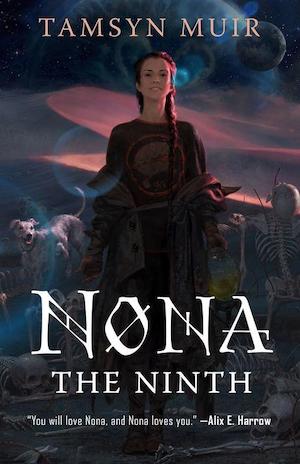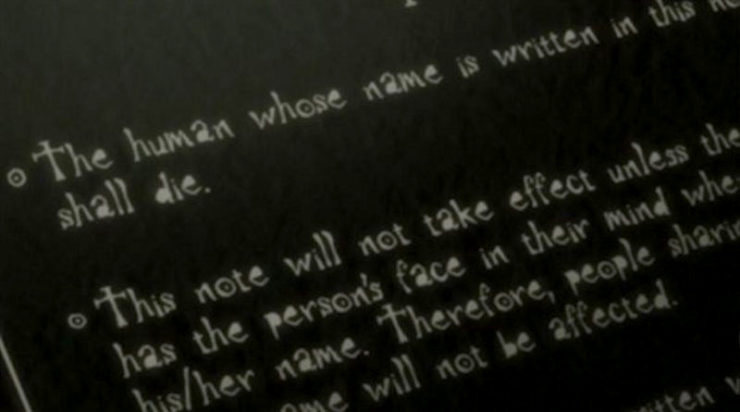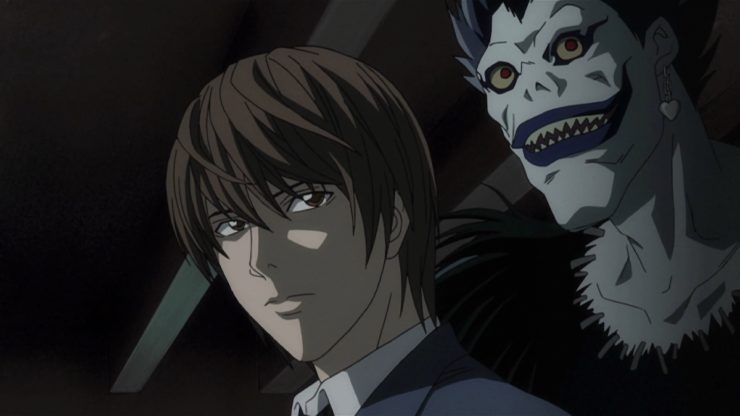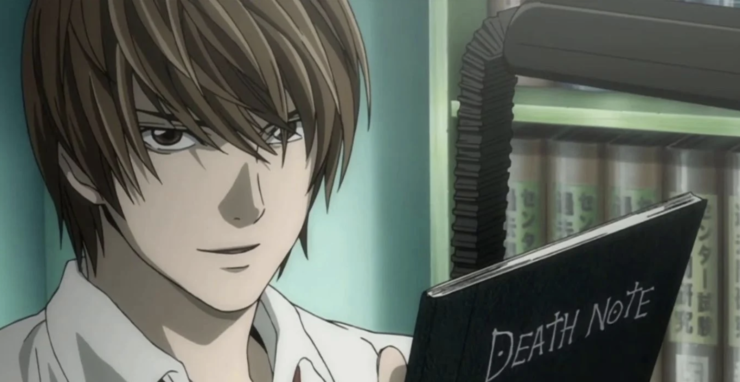There’s a lot to be said about the intersection of fantasy and the insanely large pantheon of anime content, to put it mildly. Today, I’d like to focus on Death Note and its smart, if a bit on-the-nose, use of a hard magic system to tell its story.
My anime sample size is relatively small, but thus far I’ve encountered a wealth of soft magic systems—powers with ill-defined rules or none at all. They’re a blast to watch; Saitama’s overpowered nonchalance in One Punch Man always makes me chuckle. Full Metal Alchemist: Brotherhood ventured further into hard magic territory with Equivalent Exchange, making it a fitting destination or entry point for eager magic-savvy viewers.
And then we have Death Note, a cat-and-mouse tale fueled by a magic system so thoroughly plotted, it lists rules on title cards before and after commercial breaks. Now, when I encounter a fantasy-curious friend who struggles with the intricacies of a magic system governed by strict rules, I’ll encourage them to give Death Note a try. The anime lays its rules bare, guiding the viewer as much or as little as needed…
Should a reader’s curiosities and tastes line up juuuust right, Death Note can act as an excellent gateway into the complex magic systems found in books such as Brandon Sanderson’s Mistborn.
(First, a word of reassurance: I’m not going to discuss anything following the Yotsuba arc of Death Note. The final dozen episodes weren’t for me, but I watched ‘em anyway.)
Buy the Book


Nona the Ninth
Death Note stars Light Yagami, a young man who encounters a mysterious notebook with dark powers. The Death Note, which belongs to a Shinigami (a god of death), grants its wielder the ability to kill anyone, so long as the writer knows the person’s name and face. Upon finding the Death Note, Light strikes a friendship-slash-partnership with its owner, the Shinigami Ryuk. Light begins to kill criminals as he sees their names and faces on the news, attempting to rid the world of wrongdoers. Eventually, sharp minds and investigators start to catch on, and they dub the elusive killer “Kira.” The series follows Light while he evades Kira’s pursuers and refines his methods to keep his killings untraceable. The primary arc of the Death Note anime pits Light against the quirky investigator L, whose keen powers of deduction prove a strong weapon against Light’s plotting.
Death Note reveals the titular notebook’s magical, lethal powers in a steady drip. The show doles out some of the notebook’s basic abilities through narrative exposition, either in the form of Light reading the rules or Ryuk explaining the finer complexities to him. The explanations can be heavy-handed, but that’s part of what makes Death Note’s magic system accessible.
Truly heavy-handed, bordering on ham-fisted, are the anime’s pre- and post-commercial break title cards. These appear twice in each episode, and every entry logs a different Death Note rule, laying it out for the viewer to understand in all its glory. A few of the early rules establish the foundation for the wackier ones to come. Here’s the first rule viewers encounter:
“The human whose name is written in this note shall die. This note will not take effect unless the writer has the subject’s face in mind when writing his/her name. This is to prevent people who share the same name from being affected.”

Boom. Rule number one essentially says “That’s what’s up. Deal with it.” It also raises plenty of questions, which further rules account for (with varying effectiveness).
Three other early rules refine the process and clarify the concepts set forth in the first stipulation:
“If the cause of death is written within 40 seconds of the subject’s name, it will happen.”
“If the cause of death is not specified, the subject will die of a heart attack.”
“After writing the cause of death, the details of death should be entered within the next six minutes and 40 seconds.”
With these four rules, Death Note establishes the crux of its magic. The series relies on the system to drive its story, so it’s imperative that the viewer understands. A missed connection or a rule perceived to be broken would throw the entire Death Note narrative into disarray. Throughout the show’s run, it reveals new rules and refinements that codify the system into a useable and understandable system around which Light and his enemies must navigate. Light uses the rules to find loopholes to avoid capture, while L and his investigators identify patterns in Kira’s trail of victims to better understand the parameters that govern his killings.
I won’t spoil the fun of discovering all of Death Note’s rules. If you’re interested, I encourage you to watch the show or, if you’re curious, peruse the Death Note wiki to learn more. (Beware spoilers, of course!)
How, then, can Death Note prepare rookie fantasy readers for the hard magic systems contained in some of the genre’s most amazing tales?
Consider Death Note—specifically the anime, though it began as a manga and has spawned other adaptations—training wheels for magic systems. It’s not the system itself priming fans for the intricacies of something like Mistborn’s allomancy or feruchemy, to use one favorite fantasy work as our example—it’s the delivery method. Death Note’s medium allows the show freedoms that fantasy writers would have to justify with long stretches of text. Consider the classic advice to “show, don’t tell” that we’re all familiar with—the perennial adage insists that writers should allow their readers to learn about the world of the story in indirect ways, rather than through more basic exposition; it’s a rule that permeates fantasy fiction…but Death Note takes a different approach to storytelling.

When Death Note displays its rules, stark and apparent to all, it’s telling. When Light uses the Death Note’s powers or discusses the implications with Ryuk, it’s showing. Death Note, in other words, has the benefit of both methods. The anime tells us a rule, then shows us how it works in Light’s world. This approach leaves precious little room for confusion. The rules exist. They’re displayed on a big red screen in a distinctive, stylized font. If you read them, you amplify your understanding of the notebook’s powers, which in turn fortifies your understanding of the story. Death Note operates within the strict confines of its rules, so the viewer doesn’t feel cheated when Light or L uncovers a useful loophole.
Plus, hearkening back to the literary insistence on Showing versus Telling, it’s generally frowned upon for a writer to simply list the rules governing their magic systems. The heavy-handedness fuelling Death Note works thanks to its medium and story. In a fantasy book, not so much. Readers—or at the very least, me, specifically—prefer to glean information more organically from the world, characters, and interactions. A lengthy info dump or forceful deluge of magical rules inevitably feels like cheating in a fantasy book. Of course, audience expectations and readers’ tastes vary, and there’s a lot to be said for finding a comfortable middle ground between showing and telling—that kind of balance can make for a well-crafted and accessible story.
And that’s where Death Note can be a real help to new readers who struggle to understand complex magic systems with myriad rules and stipulations. The anime presents them openly, not asking too much of the viewer upfront. Compared to a fantasy book like Mistborn, where the reader must learn the system over time with little to no detail to start with, Death Note feels more palatable and accessible to someone who isn’t already used to a slow burn.
If you’re hesitant to dip your toe into epic fantasy waters replete with hard magic systems, consider giving Death Note a try. It won’t ask too much of you, nor will it assume your knowledge of its inner workings without first giving you the lowdown. If you enjoy the story spurred by Light’s adventures with the murderous notebook, it might be a good stepping stone into other fantasy worlds where the magical rules aren’t delivered up front, but can be learned along the way as you immerse yourself in the experience.
Cole Rush writes words. A lot of them. For the most part, you can find those words at The Quill To Live or on Twitter @ColeRush1. He voraciously reads epic fantasy and science-fiction, seeking out stories of gargantuan proportions and devouring them with a bookwormish fervor. His favorite books are: The Divine Cities Series by Robert Jackson Bennett, The Long Way To A Small, Angry Planet by Becky Chambers, and The House in the Cerulean Sea by TJ Klune.










